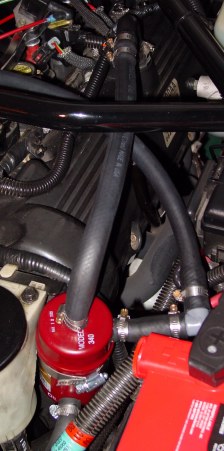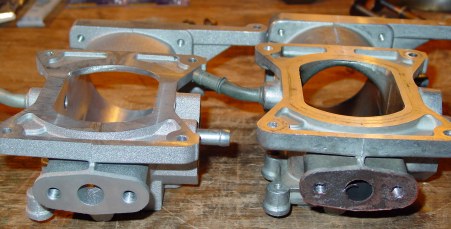Oil Removal
Oil is unintentionally introduced into the intake track via the PCV system. The PCV system vents crank case blow-by which contains oil vapor. This vapor is burned during the combustion process, but it also tends to pool up over time in the intake manifold. The oil vapor also reduces the effective octane rating of gasoline, making a car more likely to detonate. For these reasons (and to have a cleaner running car, have to keep the California smog-nazis happy...) I rigged up a way to remove the oil from my intake charge. I purchased a Temprite model 340 oil/air separator. This separator is used in industrial applications and has a 99.999% oil removal rate, removing particles down to 0.01 micron in size. I routed the driver's side valve cover through a separator and then ran the oil return line down to tie into the oil return from my supercharger. I haven't made the oil return connections yet because I'm curious to see how much oil my car was ingesting before.

Driver's side air/oil separators
Oil return lines, plugged for the moment
The next step in my improved PCV system was a way to keep boost out of the crank case (the stock Ford PCV valve was never really intended to be used in a boosted application). I purchased an Andair check valve (gray cylinder in the center of the picture below) from an aircraft supply company and installed it in the line that connected the upper intake to the driver's side air/oil separator (or driver's side valve cover in stock setups) to keep the boost out of my PCV system and crank case.
Power Pipe
I installed a Morpheus Performance Horsepower Pipe. It's 4" in diameter and JetHot coated. I should see 2-3 psi more boost and a couple more ponies with this pipe. It's a much nicer looking piece that the stock 3.5" tube, too.
I noticed that my old inlet tube had rubbed the hood a little bit, so to protect my Jet Hot coated Horsepower Pipe I notched out my hood.
Upper Intake
Ben Alameda Racing does a nice port job on the stock upper intake manifold. The net result is an increase of 52cfm through the intake. The B.A.R. piece is on the left.

I also replaced the lower intake manifold with a 2003 unit. The '03 unit has an aluminum coolant crossover tube in the front (instead of plastic) for additional strength.
Throttle Body
I added a Ford Racing Performance Parts 70mm throttle body. The throttle body is about 2mm bigger on the front and a full 5mm bigger on the back. It flows about 20cfm more than the stock 65mm unit.
Front, stock 65mm is on top.
Back, stock 65mm is on top.
Mass Air
I added an 83mm Pro-M mass airflow meter to increase power and help with general driveability. The Pro-M meter's sample tube is placed inside the filter element which allows for a true 83mm inner diameter, as opposed to the stock 80mm unit with the large sample tube taking up valuable air space.
Mounted low in the front fender to inhale cold air with my homemade bracket.
I was experiencing some slight surging at very light throttle due to the air blowing through the openings in my Saleen bumper cover and directly onto the air filter. Apparently the MAFs for these cars don't respond well to rough air. Some floor tile from Home Depot blocked the holes off and the surging went away.
Bypass Valve
I upgraded the stock bypass valve with a Vortech racing bypass valve. The Vortech unit flows a lot more air and is capable of sustaining higher horse power and boost levels. This valve should help combat heat soak and compressor surge, the bane of any supercharger.
Supercharger
The gentleman who owned the car before me didn't think that the stock S281 was quick enough, so he had a Vortech S-trim supercharger installed. The system for the 1999s came with a 7" K&N cone filter (inhaling from in front of the passenger side front wheel) and 30 lb/hr. injectors (both of which have been replaced, see below and the Electronics page), but does not use a larger fuel pump or an additional inline pump (I have upgraded the fuel pump, see the Electronics page). A Superchip chip is also provided with the kit (see Electronics for my new computer tune). The system also included a small bypass valve (which I replaced, see pictures above) and runs 6 to 8 pounds of boost. |